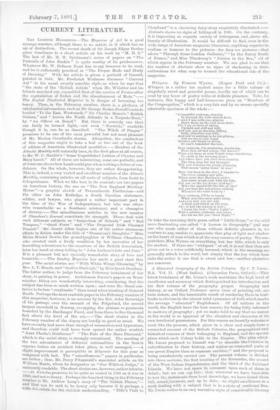CURRENT LITERATURE.
THE LIGHTER MAGAZINES.—Tile Magazine of Art is a good average number, although there is no article in it which has an air of distinction. The recent death of Sir Joseph Edgar Boehm gives timeliness to a short article on his work by "M. H. S." The last of Mr. M. H. Spielmann's series of papers on " The Portraits of John Ruskin " is quite worthy of its predecessors. Whatever Mr. W. Holman Hunt has to say deserves to be read, and he is sufficiently practical in "The Proper Mode and Study of Drawing." With his article is given a portrait of himself, painted in 1845. Mr. Frederick Wedmore discusses " Current Art " in his usual sweetly sensible style, as when he says that "the state of the 'British Artists' when Mr. Whistler and his friends marched out, resembled that of the armies of Franco after the capitulation of Sedan and the abandonment of Metz."
The English Illustrated Magazine is in danger of becoming too heavy. Thus, in the February number, there is a plethora of substantial information, such as Sir George Baden-Powell's article headed "To the East, Westwards !" Sir Charles Bruce's " British Guiana," and "Across the North Atlantic in a Torpedo-Boat," by "An Officer on Board." But there is scarcely one that can fairly be termed light,—not even " Norwich," readable though it is, can be so described. "The Witch of Prague" promises to be one of the most powerful but not most pleasant of Mr. Marion Crawford's stories. Altogether, the conductors of this magazine ought to take a leaf or two out of the book of editors of American illustrated monthlies.—Readers of the Atlantic Monthly will naturally turn, in the first place at all events, to Mr. W. C. Hazlitt's " Some Unpublished Letters of Charles and Mary Lamb." All of those are interesting, some are pathetic, and at least one shows how Lamb could pun when writing a letter of con- dolence. On the whole, however, they are rather disappointing. This is, indeed, a very varied and excellent number of the Atlantic Monthly, containing articles on all sorts of subjects, from Scott to. Schoponhauer. What we like best in its contents are two papers on American history, the one on "The New England Meeting- House "—a graphic sketch of Transatlantic Puritanism—and the other on John Rutledge, a South Carolina statesman, soldier, and lawyer, who played a rather important part in the time of the War of Independence, but who was other- wise remarkable as a Southern aristocrat, and a champion of slavery.—The miscellaneous articles in the now number of Chambers's Journal constitute its strength. These deal with such different subjects as " Inspection of Schools " and " Bad Tempers," "Good Form" and "Tine Proposed Irish Channel Tunnel." Mr. Grant Allen begins one of his rather strenuous efforts in fiction under the title of " Dumarosq's Daughter." Miss Meats Muriel Bowie, the granddaughter of William Chambers, who created such a lively sensation by her narrative of her travelling adventures to the members of the British Association, tries her hand at story-telling in " John Latham's Life and Fate." It is a pleasant but not specially remarkable story of love and homicido.—The Sunday Magazine has made a good start this year. The serial stories are " With White Wings Gleaming," by Mrs. L. T. Meade, and " Godiva Durleigh," by Miss Sarah Doudney. The latter author, to judge from the February instalment of her story, is gaining in power. Archdeacon Farrar's papers on West- minster Abbey are wonderfully interesting, considering that the subject has been so much written .upon ; and even Mr. Stead con- trives to be less " corybantic " than usual when treating of General Booth, Perhaps the most readable paper in the February number of this magazine, however, is an account by the Rev. John Beveridge of his passage over the summit of the Folgefond, the second largest snowfield in Norway, occupying the plateau or peninsula bounded by the Hardanger Fiord, and from three to five thousand feet above the level of the sea.—The short stories in the February number of the Argosy are hardly so good as usual. We have recently had more than enough of mesmerism and hypnotism, and therefore could well have been spared the rather weakish " Aunt Phoebe's Heirlooms." " The Fate of the Hara Diamond," which is the serial story, is strongly sensational. The meeting of the two adventurers of different nationalities in the Scotch express before an accident takes place, is well managed.—A slight improvement is perceptible in Belgravia for this year as compared with last. The " miscellaneous " papers in particular, are better; thus, Mr. Percy Fitzgerald's anecdotal article on Sir William Maule, whom he designates as "Our Wittiest Judge," is eminently readable. The short stories are, however, rather inferior.
—Si. Nicholas promises to be quite as varied in 1891 as it was in 1890, and not so heavy. Perhaps the heaviest thing in the February number is Mr. Andrew Lang's story of "The Golden Fleece,"— and that can be said to be heavy only because it is perhaps a trifle too subtle for the childish understanding. " Elfie's Visit to Cloudland" is a charming fairy-story exquisitely illustrated.— Atalanta shows no signs of falling-off in 1891. On the contrary, it is improving as regards variety of letterpress, and, above all, beauty of illustration. It would be difficult to find, even in the wide range of American magazine literature, anything superior in realism or humour to the pictures—for they arc pictures—.that adorn " Through Some London Galleries," "In the Sunny South of France," and Miss Thaokeray's " Fairies in the Box," all of which appear in the February number. We are glad to see that the readers of Atalanta show no signs of slackening in their enthusiasm for what may be termed the educational side of the magazine.










































 Previous page
Previous page